A Game of Cardboard Roulette
It’s what every collector hopes for. You open a pack and there’s a card that stands out from the rest. It isn’t like the others, so it must be something good. You pull it out and you’re hit with immediate disappointment when you see that the back looks like one of these:
You’ve hit a redemption card. Maybe it’s something good, maybe it’s junk. One thing’s for sure: you won’t be seeing the card for a while, if ever. Redemptions can help to get better cards into products, but they have become so prevalent in recent years that collectors have come to dread the prospect of dealing with yet another one. It seems like everyone has at least one outstanding redemption; some people have hundreds stuck in Pending limbo. If it’s a minor card you really want, it doesn’t hurt much to wait. But what do you do if you pull something like this?
Now you’re left with quite the conundrum. Do you redeem it and wait? Sell it now and let someone else deal with it? Will the price go down in the meantime or will the live card be worth more? Why do the card companies do this to us anyway? Let’s break down something we’ve been dealing with since the turn of the millennium but have yet to truly come to terms with.
Redemption Justification
Signing Scheduling
Most redemptions are issued for one simple reason – they are for autograph cards that are waiting to be signed. What happens is that a player agrees to sign a certain number of cards and/or stickers and then doesn’t sign them. Many of these are for prospects who haven’t done much signing or young stars who can’t keep up with demand. As soon as the autographs can be obtained (which can take several years in some cases), they’ll get sent out to waiting collectors. That sounds simple enough.
For superstars and retired greats, there’s a twist – these guys typically only sign once or twice each year, so whatever cards haven’t been produced in time will have to wait until next year. Or the next year. Or the next year… That Seaver by the way wasn’t on the list of cards signed in his 2013 signing session, so the wait continues.
Half and Half
Sometimes a card company is able to get some autographs but not enough for all of the cards they plan to insert. This is most common with sticker autographs, for obvious reasons. When this happens, the typical solution is to use what is available on the most limited cards (1/1s, #d/25, etc.) and make the more common variety a redemption. This makes sense and was what Panini did with the Akeel Morris autographs above; the base version was released as a redemption while the low-numbered parallels were live.
And then there’s 2013 Topps Tier One. Last year’s Tier One was plagued with redemption autographs throughout its checklist and the assorted parallels with no clear pattern. The common players were featured on two different cards (a lame trick to keep print runs low without making the desirable autographs more common) and all autographs had copper ink parallels numbered to 25, silver ink parallels numbered to 10, and gold ink parallels numbered 1/1. Redemptions tended to be a mix of all ink types with some of each color also available live, sometimes within the same card number. Even with only 25 copies, some of each of the two Jeurys Familia copper autographs were live while others were issued as redemptions. Are you kidding me? How the heck does that happen? Did the marker break while Familia was alternating between signing cards JF1 and JF2? I guess this is the sort of innovation we get from an exclusive license…
Combination Coordination
It isn’t as much of an issue now that stickers have become commonplace, but multiplayer autograph cards used to be prime candidates for redemptions. When multiple players have to sign the same physical objects, the difficulty increases exponentially. Still, there’s nothing like them, so they can be worth the wait.
Oversized Baggage
One type of redemption that there’s no way to avoid is the case where the item simply won’t fit inside the packaging. No matter how you fold it, you’re not going to fit a full jersey into a pack of cards unless you make every pack large enough to hold a jersey. Bats, balls, hats, etc. have all been included as extremely limited bonuses that could only be made available through redemption cards.
Manufacturing Delays
Another mundane reason for redemptions is the always popular supply chain SNAFU. For cards with manufactured relics or game-used memorabilia, shipping delays or difficulties in sourcing material can delay production until after packout. This seems to have been the case for the hat logo patches in 2012 Topps Heritage Minor League Edition, which were all issued as the generic sticker-type redemption usually reserved for last-minute substitutes.
Rookie Debuts
Even base cards can fall victim to the scourge of redemptions. There’s plenty of incentive to get the hottest rookies into every product, so inevitably there will be products that can’t get a big rookie into the checklist in time for production but still have a window to get a stand-in ready for packout. One of the earliest examples of this was 2001 Topps Gallery’s card number 151 featuring Ichiro Suzuki with either English or Japanese text.
What to Expect When You’re Expecting a Redemption
Let’s say you decide to redeem the redemption card and hope for the best. You enter the code online and:
a. Get a generic congratulatory message and have yet another card added to your redemption list as ‘Pending’ (Topps)
b. Have a rather formal looking request listing added to your Open Requests page (Panini)
c. Watch your screen explode in dancing swirliness before settling back down to a generic list (Leaf)
d. Whatever Upper Deck’s redemption system does
What happens next? Well, it depends. Much like the variety of reasons for issuing a redemption card, there are a multitude of possible outcomes once they are redeemed. Some of these are a bit more welcome than others.
Not So Fast (or Not Fast Enough)
The worst possible outcome is to pull a redemption card for a big star (like the 2000 UD Ionix Derek Jeter autograph, for instance) only to find out that it has already expired. This used to happen a lot; some redemptions expired at the end of the year they were issued, making last year’s product a lot less valuable. Eventually, collectors cried foul and more reasonable expiration dates were set to at least 2 or 3 years from the product release date. Some companies honor expired redemptions when possible, hold expired redemption raffles, or find other ways to give you some value for a hit that you missed.
Lost in the Mail
Luckily, this one doesn’t come up much anymore. In the beginning, there was no online redemption, so getting a card redeemed required two trips through the hands of the USPS. As you would expect, some of these cards did not reach their destination. I experienced this for the first time with a 2000 SP Authentic Jeff Bagwell autograph redemption card that was never received by Upper Deck. That one still stings.
Yes, Substitutions
Redemption cards aren’t guaranteed. You should expect something, but sometimes things don’t work out. Back in 2001, Keith Hernandez was due to have his first certified autograph card in Topps Archives, but the cards weren’t ready at packout. Even though it would probably show him with the Cardinals, this was a must-have card for me. What I got though was this:
That’s not Keith Hernandez, nor is it a Met or a Cardinal. As far as value, it’s a reasonable replacement. Sometimes deals fall through and cards don’t get made, so all the issuing company can do is offer equivalent value in cards or product. Sometimes they get it right, sometimes you get hosed. Last year, Topps created a set of sticker autograph cards specifically to use as redemption replacements. Unfortunately, value was not a consideration; you could get a Gary Carter autograph numbered to 50 or you could get a base Ike Davis auto. Basically, Topps grabbed a bunch of extra autograph sticker sheets and found a way to burn through them and placate long-suffering redeemers at the same time. This was not well received.
Quick Turnaround
Enough with the doom and gloom, this is the outcome you want to see. You enter the code online and have the card in hand within a week. If you don’t believe this can happen, you must have done all of your redemptions through Topps. Leaf and Panini however have shown that they can turn around redemptions in days and not weeks. If they have the cards in hand when you enter the redemption. Otherwise, well, start working your way down the rest of the list…
Allow 6-8 Weeks for Processing
That’s the Topps motto when it comes to redemptions. Even when they have the card in stock and ready to ship, you can expect about a two month wait for the card to ship. This was the case when I redeemed this Myron Ginsberg autograph in early 2013, shortly after he passed away. The cards were obviously in stock (he clearly wasn’t going to be signing any more), but it was still almost two months before I had the card in hand. Topps recently followed Panini’s lead and started a weekly redemption status update to let collectors know when cards are signed. They still tell their customers to expect a wait of at least a month.
Patience is Rewarded
When you enter a redemption code shortly after it is issued, you can expect a wait of at least a couple of months (assuming that the code is even recognized, sometimes they forget to enter codes into the system before a product launches…), plus the aforementioned 6-8 weeks. While not ideal, it’s hard to get too upset about this sort of turnaround. This was the case for the R.A. Dickey and Zack Wheeler cards shown above. In the case of the Wheeler (released on October 25), Topps announced the signing on December 16 and shipped mine on January 27. Less than four months for redemption fulfillment is a win in my book.
Better Luck Next Year
If you’re still waiting after four months, there’s a good chance that your total wait will exceed a full year. After all, that sort of delay is an indication that something has gone wrong with the signing process. At that point, it could take several more months for the company to make new arrangements with the player and get things back on track. This seems to have been the case with Kevin Plawecki, who had autographs issued as redemptions in 2012 Panini Elite Extra Edition but didn’t sign any of them until more than a year later. Even then, only the parallels numbered to 50 or less have been signed so far; the wait continues for the rest. To Panini’s credit, I had the card above in hand a few days before Panini announced the signing, no “4-6 weeks for processing” here.
Or the Next…
If you think it’s bad to have to wait a year for redemption fulfillment, you’ll love it at the two year mark. That’s when you’re not sure you’ll ever be getting anything. If the card isn’t really worth anything, you just write it off as a loss and move on with your life. But if it’s something valuable, the wait only gets more tense as the months turn into years. This was the case when Topps issued its second round of Matt Harvey autographs as redemptions in 2011 Bowman Platinum. At the time, these cards were selling for less than $10, a decent price for second-year autographs from a promising first-round draft pick. While other redemptions from that product were turning around in just a few months though, the Harvey auto was getting nowhere. Finally, 19 months later, Topps issued this ray of hope:
@CollectTheMets cards were dropped off with Matt in Port St Lucie yesterday, hopeful will be signed shortly!
— Topps Company (@toppscards) February 28, 2013
By this point, Panini had managed to get a few hundred Harvey autos into a few products while Topps hadn’t released a live Matt Harvey autograph since his debut in 2010. In the meantime, Harvey’s solid MLB debut in 2012 and hot start to 2013 had his card prices skyrocketing. By late April, unused redemptions were selling for close to $100. Matt Harvey was now the hottest player in New York (Derek who?) but Topps remained silent on the status of his redemptions. What happened after they were dropped off? Nothing new was reported until two days before 2011 Bowman Platinum’s two year anniversary.
Thank you @MattHarvey33 you just made a lot of collectors very happy! Lets go @Mets pic.twitter.com/3WaQm7farw
— Topps Company (@toppscards) July 25, 2013
After spending a year playing across town from Topps HQ, Matt Harvey had finally signed his 2011 Bowman Platinum autograph cards. All that was left was to sit back and wait six weeks for the cards to ship…
Beaten to the Punch
There’s always risk when a player’s first autograph card is a redemption. Will it be the first to make it out to the market? Or will a later product contain the first live autos before the redemptions get signed? The latter was the case with Rainy Lara, who had redemption autographs in 2013 Panini Prizm Perennial Draft Picks and then had live autographs a few months later in 2013 Panini Elite Extra Edition. The redemptions are nowhere in sight.
Deja Vu
And now we get to one of the strangest types of redemption outcome. While you’re waiting for a redemption autograph, you see a card in a later product that seems to be the exact card you’re waiting for. What gives? This is what happened when Matt Reynolds had his first autograph card released as a redemption for a Bowman Black autograph card in 2012 Bowman Sterling. Several months later, Reynolds announced that he had signed for 2013 Bowman Chrome.
Signed 2500 cards today! My hand is killing me to say the least! http://t.co/oNhQRKdzDf
— Matthew W. Reynolds (@ReyRey_5) July 16, 2013
Did this mean that he had signed his Bowman Black autographs? Yes and no. Reynolds did in fact sign 25 Bowman Black cards. But they were inserted into 2013 Bowman Chrome. What happened to the cards that were supposed to be in 2012 Bowman Sterling? Topps, you got some ‘splainin’ to do.
Still Waiting After All These Years
Sometimes there are no easy answers. Most of the time a redemption hits the two year mark, it’s for a big star who won’t sign or something complicated like a multiple player 1/1 autographed bat knob booklet or a Mays/Aaron/Griffey autographed baseball. So why has the wait for these Tom Seaver relic cards made it that far? 2012 Topps Series 1 was supposed to have five different Tom Seaver relic cards each numbered to 10. That’s 50 total tiny scraps of material they would need. Then this came out in 2012 Topps Series 2:
That’s right, 50 Tom Seaver relic cards. Countless more have followed in the dozens of products that have been released since then. And still no sign of these 50 Tom Seaver relic cards. Just what kind of relics are they trying to get for these cards? If they needed patches, it would be a simple matter to drag Seaver out of his vineyard, throw a jersey on him, and have him throw out the first pitch at a game. What, you thought “game-used memorabilia” meant it was used by a player? Not these days. With this wait though, all I can figure is that Topps is taking the term “relic” a bit too far and plans to insert actual pieces of Tom Seaver into the cards. This could take a while…
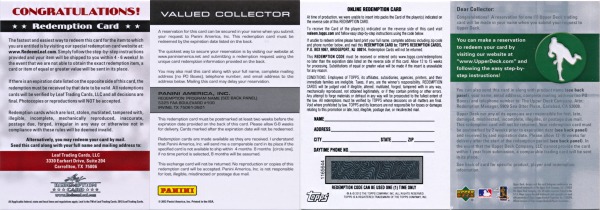
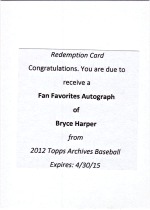
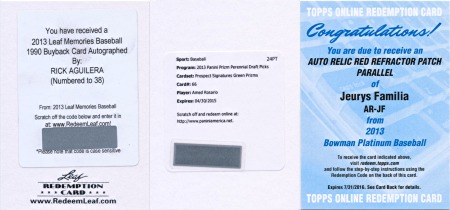
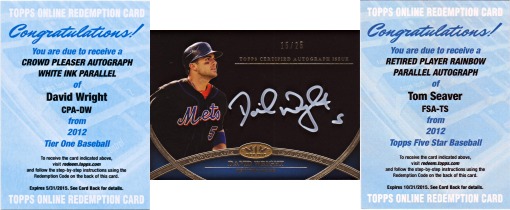
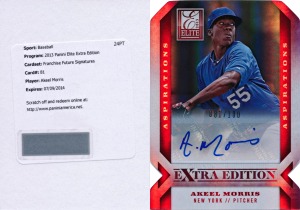

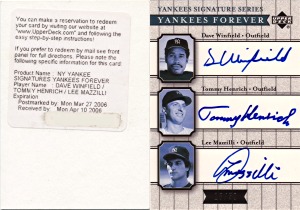

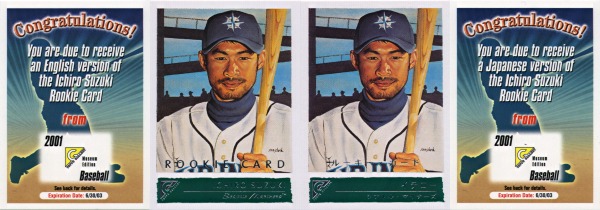

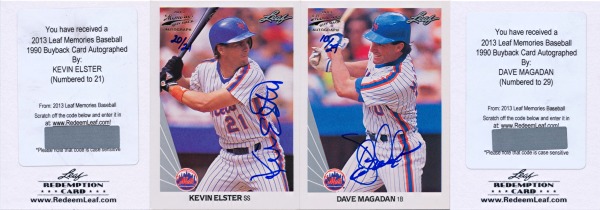
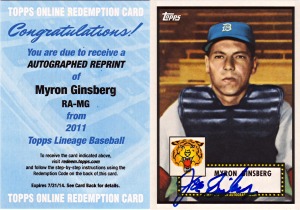

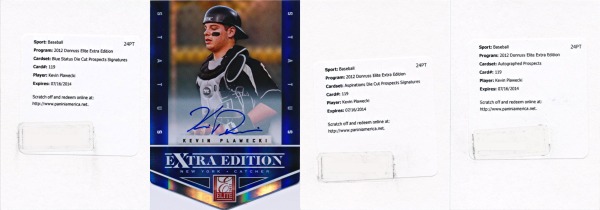
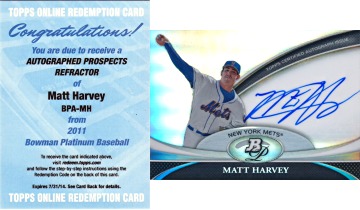
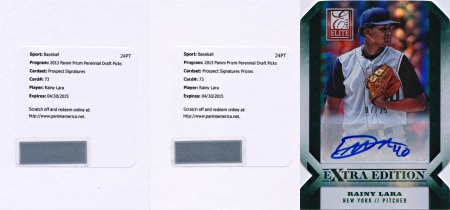
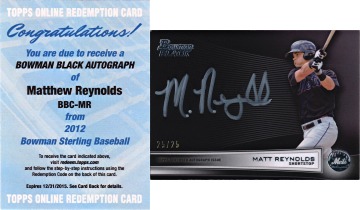
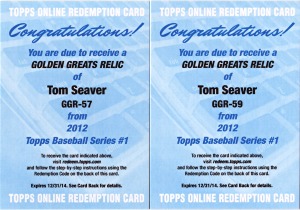
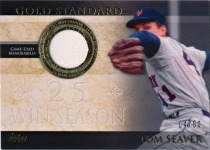
Comments are closed.